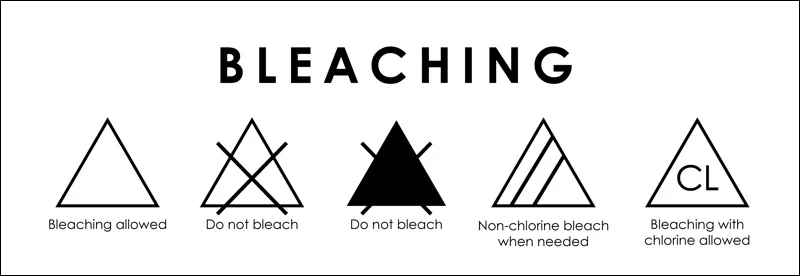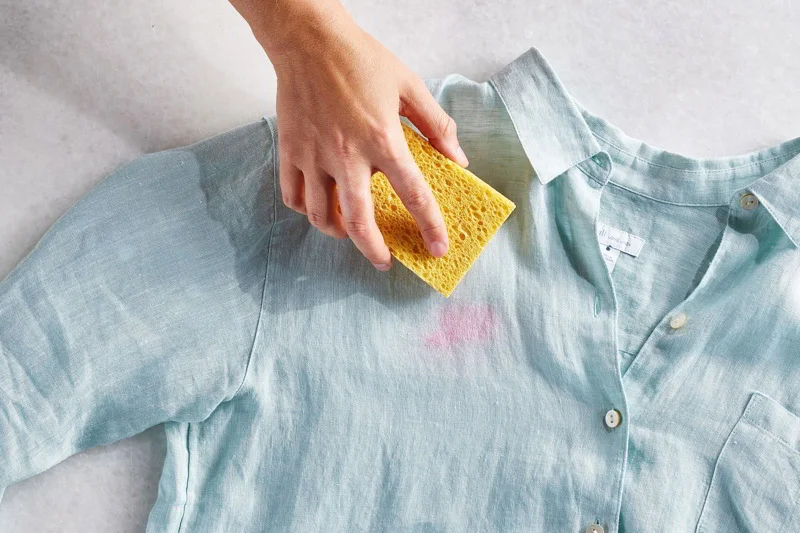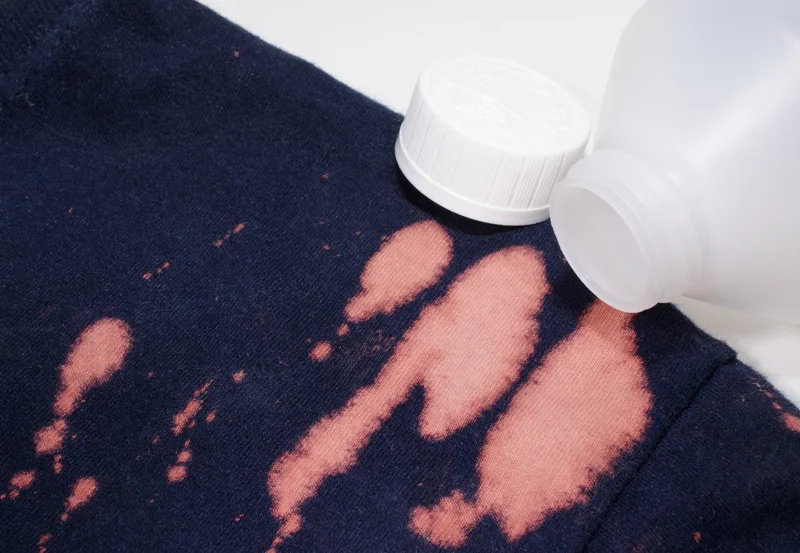Bleaching Instructions on Care Labels: Brand Guide
Confused by the bleach symbol (triangle) on care labels? For clothing brands, misunderstanding these crucial laundry icons leads to damaged garments, unhappy customers, and risks non-compliance (like FTC rules). This guide demystifies bleaching instructions.
Learn the vital difference between chlorine and non-chlorine bleach symbols (empty vs. striped triangle) and the “do not bleach” cross. Understand how to apply them correctly to your labels, preserve garment quality, reduce costly returns, and build brand trust through accurate, compliant care information. Ensure customer satisfaction and protect your brand with clear bleaching guidance.
1. Decoding the bleach symbols
Fabric care symbols serve as a universal language, offering standardized laundry guidelines directly on garment tags. While various international bodies like ISO (International Organization for Standardization) and ASTM (American Society for Testing and Materials) oversee these care symbols, the core goal remains consistent: Clear communication for proper garment maintenance. Among the most crucial, yet often misunderstood, are the symbols related to bleaching, typically represented by triangles. Let’s break down what each variation signifies.

1.1 The plain triangle
This simple, open equilateral triangle symbol indicates that the garment can be treated with any commercially available bleach type, whether it’s a standard chlorine bleach or a gentler non-chlorine alternative. Its primary suggestion often leans towards whitening, making it common on sturdy white items like basic cotton t-shirts or linens.
However, it is crucial to remember that fiber content still plays a significant role. Even if a garment is white, delicate fibers might not withstand harsh bleaching agents over time. Advising end-users to perform a spot test on an inconspicuous area before applying bleach, even with this symbol present, is a recommended best practice to ensure color safety and prevent unexpected damage.
1.2 The triangle with “CL”
When a triangle contains the capital letters “CL” inside, the instruction is specific: only chlorine bleach should be used. This type of bleach, containing sodium hypochlorite as its active ingredient, is a powerful whitening agent effective for heavy stain removal and sanitization, typically reserved for white, durable fabrics.
Due to its strength, chlorine bleach carries a significant risk of fabric damage, color stripping, and weakening fibers if used incorrectly or on unsuitable materials. Careful handling, proper dilution, and adherence to the garment’s specific care instructions are essential when this symbol is present.
1.3 The triangle with diagonal lines
This symbol, a triangle featuring two parallel diagonal lines inside, permits the use of only non-chlorine bleach, often referred to as oxygen bleach. Common active ingredients include hydrogen peroxide or sodium percarbonate. Crucially, this symbol means chlorine bleach is unsuitable and likely to cause damage to the garment’s color or fabric structure.
Non-chlorine bleach is favored for its color-safe properties and gentler action, making it suitable for a wider range of fabrics, including colored items and some delicates. Always confirm that any product used aligns with this “non-chlorine” restriction.
1.4 The crossed-out triangle
A solid triangle crossed out with a large “X” is an unambiguous warning: Do not bleach. This symbol prohibits the use of any type of bleach, including both chlorine and non-chlorine varieties. Applying bleach to a garment bearing this symbol risks irreversible consequences such as severe fabric damage, dye bleeding, discoloration, or harm to special finishes.
This instruction is commonly found on delicate materials like wool garments and silk material, items with specific dyes, or garments with embellishments or treatments that bleach could destroy. Ignoring this symbol is the direct antonym of proper garment care and almost guarantees damage.
2. Chlorine vs. non-chlorine bleach
Understanding the fundamental differences between chlorine bleach and non-chlorine bleach is essential for effective fabric care and, consequently, for creating accurate care labels. Each type acts as a whitening agent but possesses distinct chemical properties, strengths, and limitations.
Selecting the appropriate bleach type – or advising against bleach altogether – is akin to choosing the right tool for a specific task; using the wrong one can lead to undesirable outcomes for the garment.

2.1 All about chlorine bleach
Chlorine bleach, whose active ingredient is sodium hypochlorite, is renowned for its potent whitening and disinfection capabilities.
- Pros: Highly effective at removing tough stains, whitening white fabrics, and killing bacteria and viruses.
- Cons: Can cause significant fabric damage, including weakening fibers and causing holes over time. Strips color from non-colorfast items. Can yellow certain synthetic fibers and damage protein-based fibers like wool and silk, as well as spandex. Poses safety hazards if inhaled or contacts skin/eyes, and should never be mixed with ammonia or other acidic cleaners due to toxic gas release.
Due to its aggressive nature, chlorine bleach should only be recommended (via the ‘CL’ triangle symbol) when the specific fabric type can safely withstand its effects, primarily sturdy white cottons or linens. Emphasizing safety precautions during use (dilution, ventilation, protective gear) is paramount whenever dealing with sodium hypochlorite.
2.2 Understanding non-chlorine bleach
Non-chlorine bleach, commonly known as oxygen bleach, typically uses hydrogen peroxide or sodium percarbonate as its active ingredient. This alternative offers a milder approach to brightening and stain removal.
- Pros: Generally considered color-safe for most washable fabrics, gentler on fibers compared to chlorine bleach, poses fewer environmental concerns, and breaks down into water and oxygen. Effective at brightening colors and removing many everyday stains.
- Cons: Less powerful than chlorine bleach on stubborn stains or for heavy-duty whitening. May require warmer water temperatures to activate effectively (check product instructions). Not suitable for fabrics explicitly labeled ‘do not bleach’.
The significance of non-chlorine bleach in labeling lies with the triangle symbol containing diagonal lines (‘//’). This symbol is vital for garments, especially colored ones, that can benefit from some bleaching action but would be damaged by chlorine. Accurately indicating when only non-chlorine bleach is safe helps preserve the appearance and integrity of the garment.
3. Best practices for using bleach safely on garments
To ensure garment longevity and prevent mishaps during the washing process, understanding and following safe bleaching practices is crucial. Businesses should be aware of these steps, as they inform accurate care label creation and reflect responsible textile safety knowledge.
- Read the entire care label: Always check the care label first for specific bleaching instructions and other laundry guidelines (washing, drying, ironing). The bleach symbol provides the primary direction.
- Know the fiber content: Understanding the fabric composition (cotton, polyester, wool, silk, blends, etc.) helps anticipate how a material might react to bleach, even if a symbol permits its use.
- Perform a spot test: Before applying bleach to the entire garment, test a small, hidden area (like an inside seam or hem) with the diluted bleach solution. Wait a few minutes, rinse, and let dry to check for any adverse effects like color change or fabric damage.
- Dilute properly: Never pour undiluted bleach directly onto fabric. Always dilute chlorine bleach or non-chlorine bleach according to the product instructions, typically by mixing with water before adding clothes to the washing machine or soaking tub.
- Consider water temperature: While some bleaches work in cold water, others (especially some oxygen bleaches) are more effective in warm or hot water. Check both the garment’s care label and the bleach product’s instructions regarding optimal water temperature.
- Avoid mixing chemicals: Critically, never mix chlorine bleach with ammonia, vinegar, or other household cleaners. This combination can release dangerous toxic gases. Stick to using bleach only with detergent and water as directed.
- Rinse thoroughly: Ensure garments treated with bleach are rinsed completely during the washing process to remove all chemical residue, which could otherwise weaken the fabric over time.
- Ensure good ventilation (chlorine bleach): When using chlorine bleach, work in a well-ventilated area to avoid inhaling strong fumes.

4. Avoiding costly mistakes
For any clothing brand, inaccurate care labels, especially concerning bleach, represent more than just a minor oversight; they can lead to significant financial and reputational damage. A common error is incorrectly specifying the use of chlorine bleach on fabrics that cannot tolerate it, or conversely, marking an item “do not bleach” when a gentler non-chlorine bleach would be safe and effective for stain removal.
Consider the consequences: a customer uses standard chlorine bleach on a polyester blend garment labeled simply with the “any bleach” triangle, resulting in yellowing or fabric disintegration. Or, they avoid treating a stain on a colored shirt because the label incorrectly states “do not bleach,” when careful application of non-chlorine bleach might have saved the item.
These scenarios invariably lead to customer dissatisfaction, product returns, potential inventory loss if the issue is widespread, and damaging negative reviews that erode brand trustworthiness.
Furthermore, in regions like the US, adherence to the FTC Care Labeling Rule is a legal requirement. Providing incorrect or incomplete care instructions, including bleaching guidelines, constitutes non-compliance and exposes the business to potential regulatory action.
Accurate care label requirements are therefore not just about preserving the fabric; they are a critical component of risk management, consumer safety, and maintaining the integrity and reputation of your clothing brand. Precise labeling demonstrates diligence and builds consumer confidence.

5. Related questions
Here are answers to some frequently asked questions regarding bleach and garment care labels:
5.1 Can I use non-chlorine bleach on a ‘do not bleach’ item?
No, you should not use non-chlorine bleach on a garment labeled with the “do not bleach” symbol (the crossed-out triangle). This symbol indicates that the fabric is sensitive to all types of bleaching agents, including gentler oxygen-based (non-chlorine) options. Applying any bleach could lead to irreversible fabric damage, color loss, or weakening of the fibers. Always adhere strictly to the care label instructions to preserve the garment.
5.2 What if a garment is white but says ‘non-chlorine bleach only’?
Trust the care label, even if the garment is white. There are several reasons why a white item might carry the “non-chlorine bleach only” instruction (triangle with diagonal lines). The fabric itself, although white, might be delicate (like certain synthetics, blends, or treated cottons) and susceptible to fabric damage from harsher chlorine bleach.
Alternatively, the garment might have a special finish or treatment applied that chlorine bleach could strip or discolor. Using chlorine bleach against this instruction risks damaging the item.
5.3 How do I handle heavily stained items labeled ‘do not bleach’?
When dealing with tough stains on a fabric marked “do not bleach,” bleach is not a viable option. Instead, explore alternative stain removal methods suitable for the specific fabric type. Consider prompt pre-wash treatment using a stain remover formulated for that material.
Enzyme-based cleaners can be effective on protein or organic stains. Carefully applying a spot treatment directly to the stained area (after testing on an inconspicuous spot) may also work. For valuable or particularly delicate garments, seeking professional cleaning advice is often the safest approach to avoid damaging the fabric while addressing the stain.
Read more:
Mastering bleach instructions on care labels is a crucial investment for any clothing brand, directly enhancing customer satisfaction and safeguarding your reputation. By providing clear guidance on key symbols – such as the open, lined, or crossed-out triangle – and the distinction between chlorine and non-chlorine bleach, you empower consumers to prevent accidental damage and extend the life of their garments. Ultimately, this precision leads to reduced returns, stronger brand trust, and full compliance with care labeling regulations, making it a fundamental practice for operational success.






















